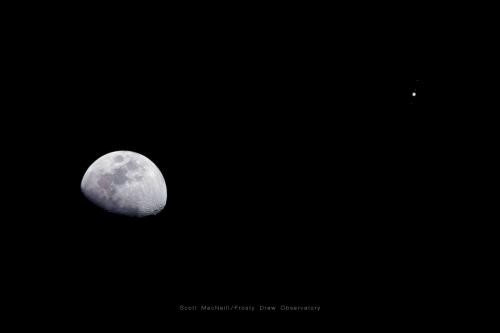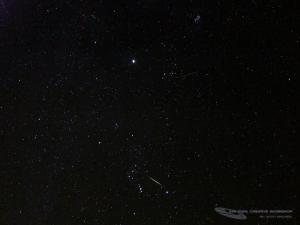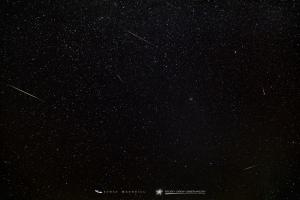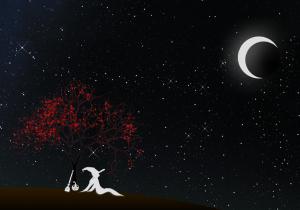Celebration of Space - October 14, 2022

The Gibbous Moon and Jupiter in conjunction in 2019. Image credit: Frosty Drew Astronomy Team member, Scott MacNeill
Tonight, October 14, 2022 around 9:30 pm, the waning gibbous Moon and Mars will put on a beautiful conjunction, with Mars sitting about 2.5º below the Moon. As we move towards Mars’ opposition on December 8, 2022, which is when we will orbit in between Mars and the Sun, the red planet will be rising earlier with each passing night. Over the next several months, there will be many conjunctions of the Moon and Mars, since they are both along the ecliptic. Step outside after 10:00 pm and look to the ENE to find the Moon. Mars will be the bright orange-red object just below the Moon.
On the Taurid Meteor Shower front, we have been seeing a nice increase in fireball activity at Frosty Drew, as well as just out and about. The Taurid Meteor Shower has two components; the Southern Taurids and the Northern Taurids. The Southern Taurid shower kicked in on September 28th, with the Northern Taurid shower kicking in yesterday, October 13th. The overlap period of both showers, which will continue until December 2nd, is the most active time of the showers. But even outside of the overlap, we have seen more fireball meteors, this year, than we usually see during the overlap. That is because the Taurid showers have a seven year outburst cycle. Meaning that every seven years Earth will pass through a denser region of, larger than average, comet debris, left behind by Comet 2P/Encke. The result is a significant increase in fireball meteor activity. The last time we had such an outburst was in 2015, which places 2022 on the up. Even on Sunday night, with the full Moon, we spotted 2 extremely bright fireball meteors within one hour. Now that the Moon is departing, and the Northern Taurid shower has begun, sightings will become much more frequent. So keep your eye to the sky, Taurid fireballs will appear blue in color and will leave persistent streaks in the sky.
Speaking of meteor showers, overnight Thursday – Friday, October 20-21, 2022 will bring the peak of the annual Orionid Meteor Shower to the sky. The Orionids are one of the better meteor showers of Autumn, aside from the fabulous Geminid Meteor Shower in early December, and will bring upwards of 20 meteors per hour to regular meteor activity. Add in that the Taurid Meteor Showers are on an outburst year, and this will be a great night to be out. The Moon, which has a significant impact on the viewing quality of meteor showers, will be sporting a 15% waning crescent, and will not rise until 2:44 am. Though the morning hours are the best times to view the Orionid shower, the Moon will still offer a good period of viewing before rise times, and at 15% crescent, will only outshine the dimmest meteors.
The Orionid Meteor Shower is a product of Comet 1P / Halley (Halley’s Comet), which leaves behind a path of comet debris along its orbit. Halley’s Comet is a periodic comet with an orbital period of about 75 years. When the comet approaches the Sun (perihelion), solar radiation will start to heat up the comet’s nucleus, causing the ice in the nucleus to sublimate (change from a solid to gas). When this happens little pieces of ice and rock end up along the path of the comet. Every October, Earth passes through this field of comet debris, which gets caught in Earth’s gravity and enters the atmosphere at speeds of 41 miles per second, and burns up. The streaks of burning pieces of comet are the shooting stars that we see.
To view the meteor shower, you will need to get out of the city, and visit a spot with minimal light pollution, and a wide open view of the night sky. All Orionid meteors will radiate from the constellation Orion, about 8º above the bright star, Betelgeuse. The radiant point of the shower will rise at 10:11 pm Thursday night, and will be nicely placed for viewing around 1:00 am Friday morning. Though meteors will certainly be visible before these times. Once at your destination, lay on your back with your feet to the south and look to the zenith (top of the sky) to catch meteors shooting by. Note that you will most certainly see a few Taurid fireball meteors this night as well, with the radiant points of the Taurid showers being at their best after 11 pm Thursday night.
Now that the Chinese National Space Administration’s (CNSA) Tiangong space station has returned to the evening sky, family friendly passes have been happening and will continue thru the weekend and next week. Family friendly passes are passes that occur during the early evening hours, usually when the whole family is home and still awake. This will make for easy viewing opportunities. Over the next few days, spectacular passes will be visible, which gives you another reason to be outside looking up! Here are a few notable passes for the next seven nights:
Fri, Oct 14 at 7:49 pm, starting in the W, rising to 70º, and into orbital sunset ← Awesome pass!
Sat, Oct 15 at 6:48 pm, starting in the W, rising to 86º, heading towards the E, and into orbital sunset ← Awesome pass!
Sun, Oct 16 at 7:25 pm, starting in the W, rising to 69º, heading towards the SE, and into orbital sunset ← Awesome pass!
Mon, Oct 17 at 8:01pm, starting in the W, rising to 27º, and into orbital sunset
Tue, Oct 18 at 7:00 pm, starting in the W, rising to 49º, heading towards the SE, and into orbital sunset
Wed, Oct 19 at 7:37 pm, starting in the W, rising to 20º, heading towards the S, and into orbital sunset
Thu, Oct 20 at 6:36 pm, starting in the W, rising to 32º, heading towards the SE
Orbital sunset happens when the station, which is visible because it’s in direct sunlight, orbits into Earth’s shadow (Umbra). When this happens the station will quickly begin to dim until it becomes invisible. During this time, any residents of the station will experience sunset. Note that these times are applicable to Southern New England, and will serve as acceptable for anywhere in the Northeast. For daily pass times of Tiangong and other bright satellites, visit the Frosty Drew Daily Satellite Pass Prediction Utility.
Save the Date!
Spooky Views – A Halloween Stargazing Experience
Friday, October 28, 2022 from 6:00 pm – 10:00 pm.
On the Friday that precedes Halloween, the Frosty Drew Observatory and Science Center will put on its annual Halloween stargazing event. In 2022 we will have a super dark sky due to the 15% waxing crescent Moon setting before 8:00 pm that night, and will allow for us to observe a handful of stars that are currently experiencing their death process. The campus will be decorated in creepy seasonal décor, with sights and sounds to please the darker side in each of us. We will host spooky (family friendly) Story Times Under the Willow, a scavenger hunt for the kids (and adults), and have two airings of the original War of the Worlds 1938 radio broadcast by Orson Wells. It is a fantastic night to visit. Costumes are encouraged but NOT required. So get your creep on under the dark of Ninigret Park at Frosty Drew Observatory and Science Center, and learn a bit about how stars die, if you’re brave enough...
- Author:
- Scott MacNeill
- Entry Date:
- Oct 14, 2022
- Published Under:
- Scott MacNeill's Columns





